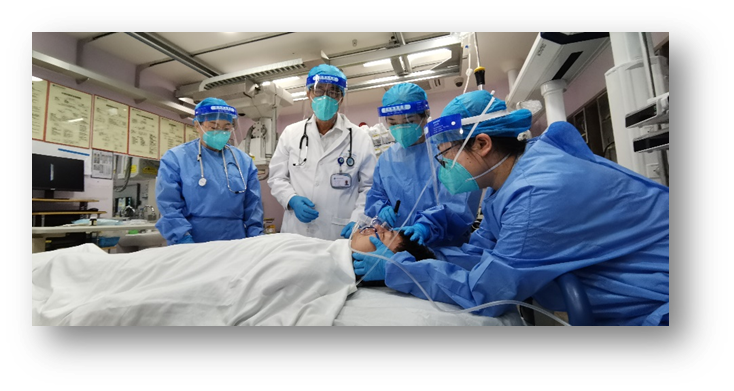After nine years of development, the nursing team of A&E Department has grown and attracted nursing talents, making it a professional team of high quality and positive energy. There are 57 nursing staff members, 31 of whom have middle-level professional titles or above, accounting for 55% of the total. Eight nurses are currently studying for master's degrees, and 53 nurses have bachelor's degrees and above. A nurse specialist has been certificated by China Nursing Association (CNA) with another nurse specialist certificated by Guangdong Nursing Association. The team undertakes the nursing work of pre-hospital emergency medical services, triage of patients, nursing services at Resuscitation Room, Observation and Inpatient Ward, EICU, General Fever Clinic, Fever Clinic, Nucleic Acid Screening Clinic and IMC A&E Division.

Exploration,Innovation and Reform
A&E Department insists on practicing the concept of "Exploration, Innovation and Reform", and is dedicated to fostering professional skills and providing quality service. Being "patient-centered", it aims to become an innovative department of the healthcare reform model in the mainland. Eyeing the international model for emergency medical services, the Department keeps in line with international standards in terms of emergency knowledge, skills and concepts.Six critical care centers have been established, including Chest Pain Center (of national standard), Stroke Center (a national advanced stroke center), Trauma Center (member of China Trauma Care Alliance), Poison Center, Pediatric and Neonatal Care Center and Maternal Care Center. Poison Center has introduced a Hong Kong poison treatment team with the goal of establishing the Greater Bay Area Poison Center.

Internationalized Training
The training and management of nursing staff have become increasingly mature through experimentation and reform, with a variety of training methods and a flexible assessment mechanism. The innovative "one person, one plan" training program meets the needs of each nurse’s career development, aiming to enhance their core competency. The emergency medical treatment model at General Practice Division helps churn out emergency nurses. More than 90% of the nurses have received BLS and ACLS training by American Heart Association (AHA), and some of the backbone personnel have been trained in PALS, Neonatal Resuscitation, ATLS/ATCN, and ultrasound (FAST) training. Different training modes are selected according to the skill level of nurses and clinical needs. The team has rolled out workshops and scenario for the training of core skills such as resuscitation and triage of patients, and OSCE is used to assess nurses to improve their clinical response. critical thinking and holistic thinking skills.
Emergency triage to build "Green Channel" for critically ill patients
When A&E Department was established in early 2013, it took the lead in implementing the emergency triage system in Shenzhen, drawing on the experience of Hong Kong. With the help of the system, it determines treatment priority according to patients’ disease severity to ensure that critically ill patients receive timely treatment. At the same time, the nursing team pays great attention to triage quality, organizes triage workshops, monitors and gives feedback on triage accuracy indicators, and ensures continuous improvement of triage quality. In the past five years, the average annual triage accuracy rate of the Department has reached 95%, which better ensures the safety of emergency patients and the reasonable allocation of treatment resources.
Develop emergency care with evidence-based practice
The nursing team has established a scientific clinical process to ensure quality and safety through evidence-based research. According to the latest international consensus and evidence-based data, the team has developed the detox treatment by using activated charcoal (oral route). In compliance with the latest guidelines, it encourages nurses to perform modified Valsalva motion for SVT, and in clinical practice, they have restored regular heart rhythm in many patients. Under the international guidelines for PALS, the team has children's emergency vehicles parked separately based on the first aid items of different age groups the vehicles carry, and the team has translated instructions on the pediatric emergency resuscitation tapes into Chinese to improve resuscitation efficiency. To meet the needs of emergency patients in hemorrhagic shock, a satellite blood bank has been placed in the resuscitation room for the transfusion of unmatched type "O" blood for patients in emergency situations.

Fight against COVID-19
In the spring of 2020, when the coronavirus epidemic broke out, the Hospital, as the designated treatment hospital for local and foreign patients with suspected COVID-19 in Shenzhen, fully involved A&E Department in the treatment of the disease. The Hospital quickly mobilized personnel and materials, standardized management process, and made every effort to carry out effective prevention measures. The Hospital took the lead in separating the general fever patients from the high-risk fever patients, which has greatly reduced the risk of cross-infection and has effectively protected the medical staff. With the rising number of confirmed cases and the continuous pressure on prevention and control, the nursing team, led by the Hospital, acted quickly to open the isolation ward and sorted out the workflow of the fever clinic and the emergency service to ensure the orderly provision of emergency care.
As the saying goes, "it is the small steps that take one to faraway places," the nursing team of A&E Department will work together and strive for a better future.








 搜索
搜索











 粤公网安备44030002006353号
粤公网安备44030002006353号